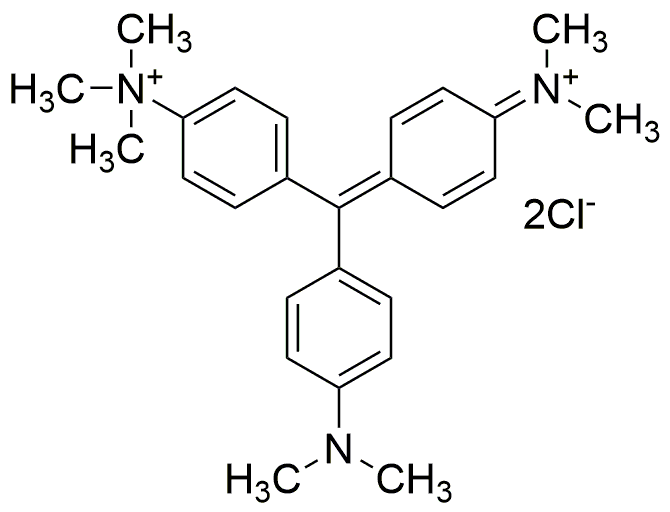Methyl green is widely utilized in research focused on:
- Histology and Cytology: This dye is commonly used for staining biological tissues, allowing researchers to visualize cellular structures under a microscope. Its ability to bind to nucleic acids makes it particularly useful for identifying DNA and RNA in cells.
- Microbiology: Methyl green serves as a vital stain in microbiological studies, helping to differentiate between living and dead cells. This application is crucial for assessing the viability of bacterial cultures in various industries, including pharmaceuticals and food safety.
- Biochemistry: In biochemical assays, it is employed to quantify nucleic acids. Its sensitivity and specificity enhance the accuracy of experiments, making it a preferred choice for researchers analyzing genetic material.
- Environmental Testing: Methyl green is used in environmental science to detect and quantify pollutants in water samples. Its effectiveness in identifying specific contaminants supports efforts in water quality monitoring and management.
- Education: This compound is frequently used in educational settings for teaching purposes. Its vibrant color and clear staining properties help students understand complex biological processes and the importance of cellular components.
General Information
Properties
Safety and Regulations
Applications
Methyl green is widely utilized in research focused on:
- Histology and Cytology: This dye is commonly used for staining biological tissues, allowing researchers to visualize cellular structures under a microscope. Its ability to bind to nucleic acids makes it particularly useful for identifying DNA and RNA in cells.
- Microbiology: Methyl green serves as a vital stain in microbiological studies, helping to differentiate between living and dead cells. This application is crucial for assessing the viability of bacterial cultures in various industries, including pharmaceuticals and food safety.
- Biochemistry: In biochemical assays, it is employed to quantify nucleic acids. Its sensitivity and specificity enhance the accuracy of experiments, making it a preferred choice for researchers analyzing genetic material.
- Environmental Testing: Methyl green is used in environmental science to detect and quantify pollutants in water samples. Its effectiveness in identifying specific contaminants supports efforts in water quality monitoring and management.
- Education: This compound is frequently used in educational settings for teaching purposes. Its vibrant color and clear staining properties help students understand complex biological processes and the importance of cellular components.
Documents
Safety Data Sheets (SDS)
The SDS provides comprehensive safety information on handling, storage, and disposal of the product.
Product Specification (PS)
The PS provides a comprehensive breakdown of the product’s properties, including chemical composition, physical state, purity, and storage requirements. It also details acceptable quality ranges and the product's intended applications.
Certificates of Analysis (COA)
Search for Certificates of Analysis (COA) by entering the products Lot Number. Lot and Batch Numbers can be found on a product’s label following the words ‘Lot’ or ‘Batch’.
Numéro de catalogue
Numéro de lot/série
Certificates Of Origin (COO)
This COO confirms the country where the product was manufactured, and also details the materials and components used in it and whether it is derived from natural, synthetic, or other specific sources. This certificate may be required for customs, trade, and regulatory compliance.
Numéro de catalogue
Numéro de lot/série
Safety Data Sheets (SDS)
The SDS provides comprehensive safety information on handling, storage, and disposal of the product.
DownloadProduct Specification (PS)
The PS provides a comprehensive breakdown of the product’s properties, including chemical composition, physical state, purity, and storage requirements. It also details acceptable quality ranges and the product's intended applications.
DownloadCertificates of Analysis (COA)
Search for Certificates of Analysis (COA) by entering the products Lot Number. Lot and Batch Numbers can be found on a product’s label following the words ‘Lot’ or ‘Batch’.
Numéro de catalogue
Numéro de lot/série
Certificates Of Origin (COO)
This COO confirms the country where the product was manufactured, and also details the materials and components used in it and whether it is derived from natural, synthetic, or other specific sources. This certificate may be required for customs, trade, and regulatory compliance.


